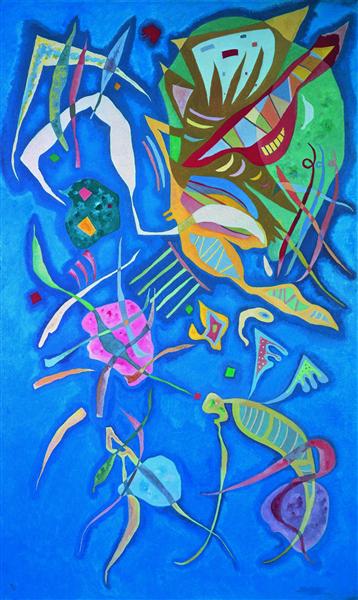Description
The work "Group" by Wassily Kandinsky, painted in 1937, is at the intersection of its artistic legacy and its continuous exploration of the relationship between color, shape and emotion. Kandinsky, one of the pioneers of abstract art, stood out for his innovative approach in the spiritual and emotional connection that artistic compositions can evoke. In "Group", their theoretical concepts around art and its influence of music are clearly manifested, where every color and shape resonates with its own hue, creating a visual symphony.
The composition of "grouping" is an interesting game of figures and shapes that are intertwined, forming dynamic groups that suggest movement and connection, often interpreted as a representation of human interaction. Although the work moves away from the detailed figurative representation, we can observe the predominance of oval and rectangular forms that seem to dialogue with each other, underlining a sense of grouping. This visual language could be interpreted as a representation of the social fabric and the interrelation of individuals within a community, reflecting the concerns of an era marked by political and social tensions.
The colors in "grouping" are another fundamental aspect that deserves attention. Kandinsky uses a vibrant and contrasting palette, predominantly yellow, blue and red tones. Yellow, which we historically associate with joy and energy, manifests itself in one of the central forms, while the blue and red, darker and deep, provide a sense of harmony and tension to the composition. This color choice is not arbitrary; Each tone is carefully chosen to evoke specific emotions, acting as a symbol of feelings that transcend the physical world and enter the spiritual.
In the work, although detailed human figures are not identified, the suggestion of the presence of characters is palpable. The forms seem to interact, as if they were involved in a visual conversation, establishing a sense of community. This emphasis of the group could be seen as a reflection of the ideals of the time, where the search for unity and community resonates deeply in the collective psyche of the post First War Society.
"Group" is part of Kandinsky's legacy as a tireless explorer of the possibilities of abstract art. His path to pure abstraction, a process that was consolidated in the first half of the twentieth century, pioneered the rupture of traditional representation. Kandinsky undertook his search with the firm belief that art should be expressive and not merely representative, an approach that announced the arrival of artistic avant -garde.
It is crucial to contextualize "grouping" within Kandinsky's trajectory and the development of abstract art. paintings As "Composition VIII" or "Improvisation 31" they offer a parallel vision to the steps that the artist gave towards his stylistic maturity. In all these works, the compositional elements and the dynamic color games reveal Kandinsky's interest in the creation of a new artistic language that evokes the essence of human experience.
In conclusion, "Group" is a work that encapsulates the deep connection of Wassily Kandinsky with abstraction, emotion and social interaction. Beyond its vibrant colors and its enveloping composition, this painting invites the viewer to consider the human experience as a whole, reflecting the utopia of a united community, while maintaining the promise of an endless exploration towards the unknown. The work stands as a testimony of Kandinsky's innovative vision, whose legacy continues to inspire and challenge the perceptions of contemporary art.
KUADROS ©, a famous paint on your wall.
Hand-made oil painting reproductions, with the quality of professional artists and the distinctive seal of KUADROS ©.
Art reproduction service with satisfaction guarantee. If you are not completely satisfied with the replica of your painting, we refund your money 100%.

